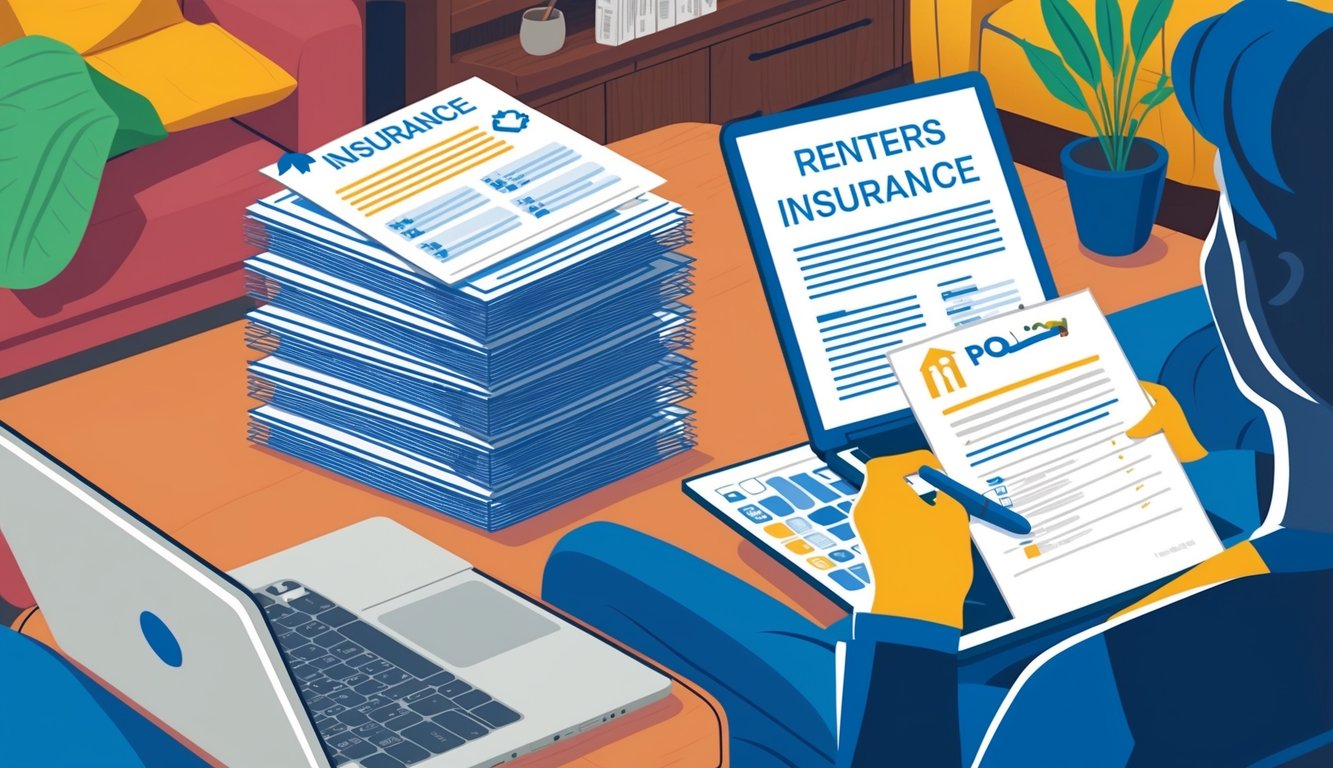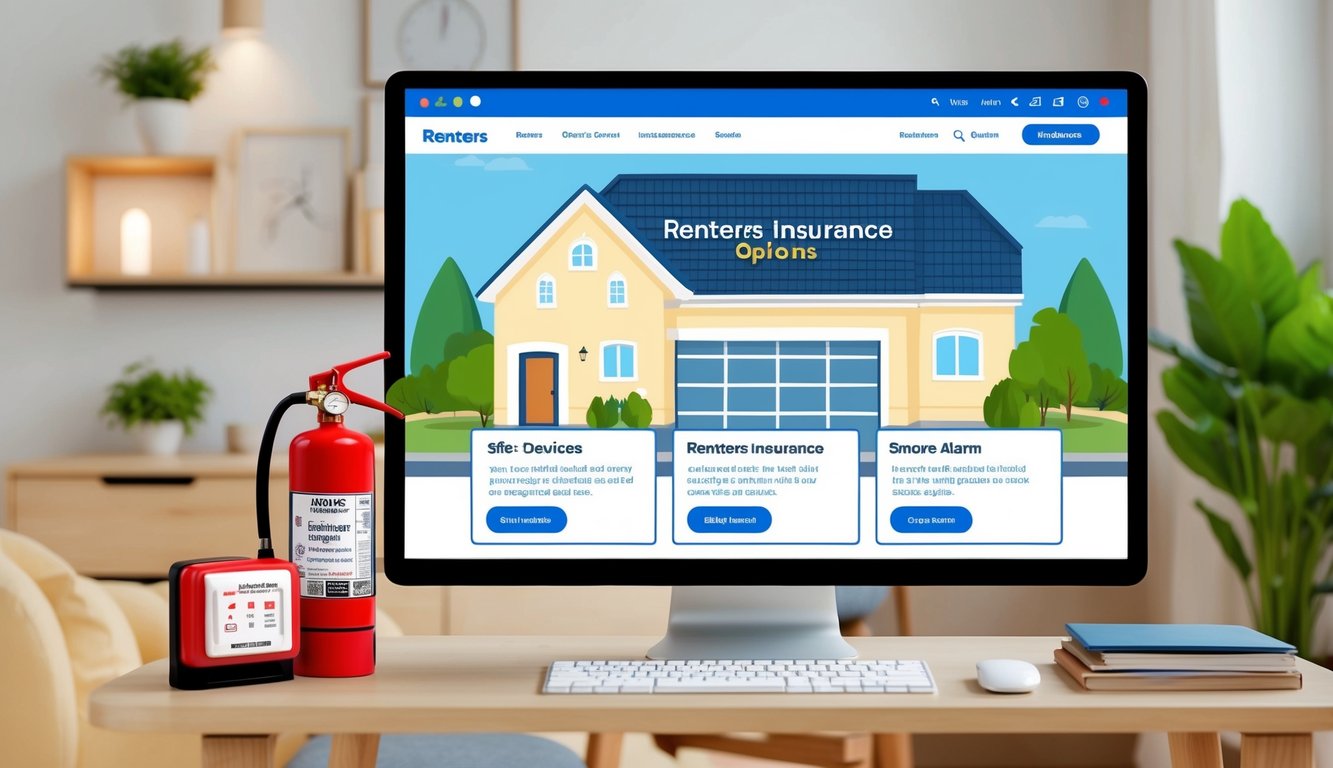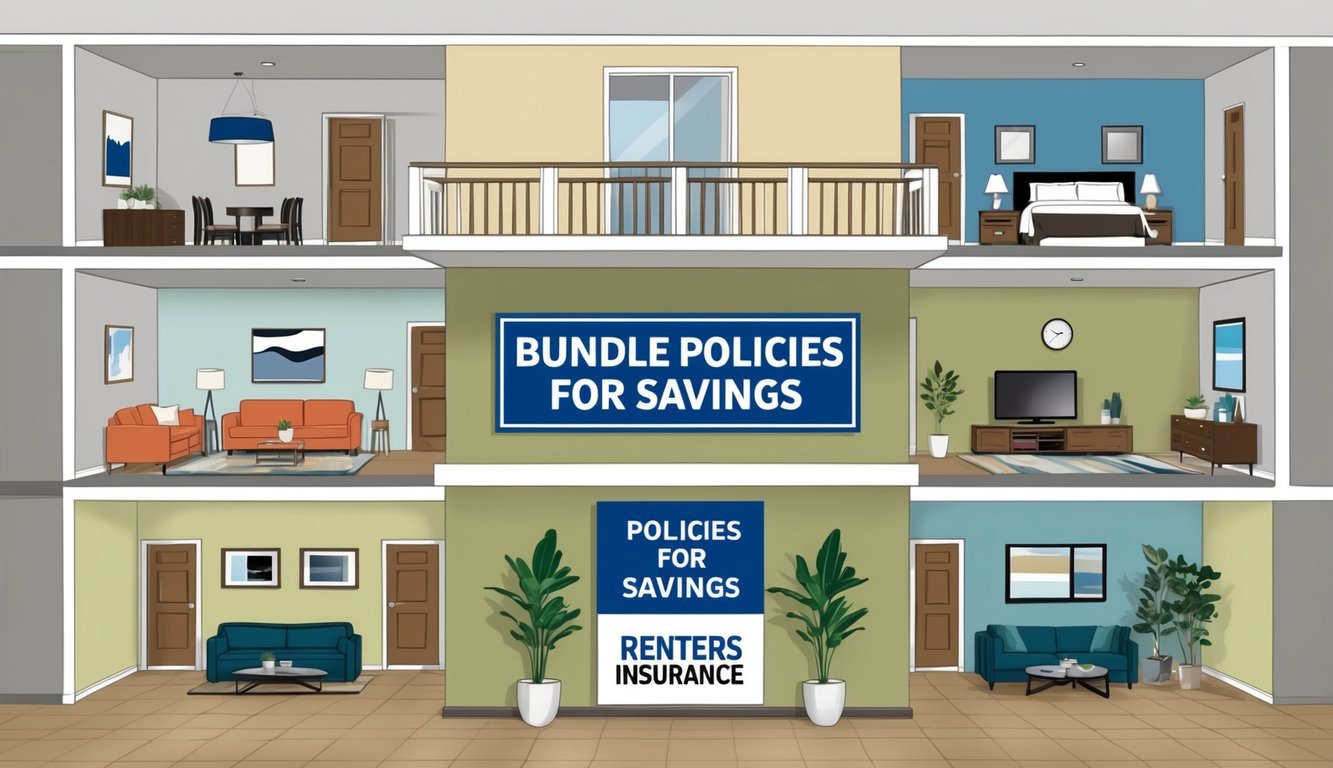Renting an apartment comes with many responsibilities, including protecting your belongings.
While your landlord’s insurance covers the building structure, it doesn’t extend to your personal possessions.
This is where renters insurance becomes crucial, offering a safety net for your valuables and providing liability coverage.
Choosing the right renters insurance involves assessing your needs, understanding policy options, and comparing quotes from different providers. By taking the time to find the best coverage for your situation, you can ensure peace of mind and financial protection in case of unexpected events like theft, fire, or accidents in your rented home.
1) Understand Coverage Types
Renters insurance typically includes several key coverage types.
Personal property coverage protects your belongings from theft, damage, or destruction.
This can include furniture, clothing, electronics, and other personal items.
Liability coverage is another essential component.
It safeguards you financially if someone is injured in your apartment or if you accidentally damage someone else’s property.
Additional living expenses coverage helps pay for temporary housing and other costs if your apartment becomes uninhabitable due to a covered event like a fire or natural disaster.
Some policies offer medical payments coverage.
This can help pay for minor injuries to guests in your apartment, regardless of who’s at fault.
You might also encounter loss of use coverage.
This helps cover extra expenses if you can’t live in your apartment due to a covered loss.
When choosing a policy, consider the value of your belongings and your potential liability risks.
You may need to decide on coverage limits for each type of protection.
Remember that standard policies often have exclusions.
Flood and earthquake damage, for example, typically require separate coverage.
Review policy details carefully to understand what is and isn’t covered.
2) Evaluate Liability Protection
Liability protection is a crucial component of renters insurance.
It safeguards you financially if someone is injured in your apartment or if you accidentally damage someone else’s property.
Most renters insurance policies include liability coverage ranging from $100,000 to $500,000.
When evaluating this coverage, consider your assets and potential risks.
If you have significant savings or valuable possessions, you may want to opt for higher liability limits.
This provides greater protection against lawsuits or claims that could jeopardize your financial stability.
Consider your lifestyle when assessing liability needs.
If you frequently host guests or have pets, you may face increased risk of accidents or injuries occurring in your home.
Some landlords require a minimum amount of liability coverage as part of your lease agreement.
Check your lease terms to ensure you meet these requirements.
Remember that liability protection extends beyond your apartment.
It typically covers you in various situations, such as accidentally injuring someone while playing sports or damaging property at a friend’s house.
If you need additional protection, you can explore umbrella policies.
These provide extra liability coverage above your standard renters insurance limits, offering more comprehensive protection.
When comparing policies, pay attention to any exclusions or limitations in the liability coverage.
Some policies may not cover certain activities or types of incidents.
3) Check for Additional Living Expenses Coverage
When choosing renters insurance, it’s crucial to consider additional living expenses (ALE) coverage.
This protection helps pay for temporary housing and other costs if your apartment becomes uninhabitable due to a covered event.
ALE coverage typically amounts to 20% of your dwelling coverage.
For example, if you have $100,000 in dwelling coverage, your ALE limit might be $20,000.
Your policy may cover hotel stays, restaurant meals, and other necessary expenses that exceed your normal living costs.
Be sure to review the specifics of what’s included in your ALE coverage.
The average cost of renters insurance is about $173 per year or $14 per month.
This usually includes ALE coverage, but it’s wise to confirm the exact amount with your insurance provider.
Keep in mind that ALE coverage has limits.
Most policies cap the coverage period, often at 12 months.
Make sure you understand these limitations when selecting your policy.
Some insurers offer the option to increase your ALE coverage for an additional premium.
Consider this if you live in an area prone to natural disasters or other risks that could displace you for an extended period.
When comparing policies, ask about the claims process for ALE.
Understanding how quickly you can access funds in an emergency is important for your peace of mind.
4) Review Policy Limits

When choosing renters insurance, it’s crucial to review the policy limits carefully.
These limits determine the maximum amount your insurer will pay for covered losses.
Pay close attention to personal property coverage.
This protects your belongings, so ensure it’s enough to replace your possessions if they’re damaged or stolen. The average renter spends about $148 a year for $30,000 of personal property coverage.
Liability coverage is another important aspect to consider.
It protects you if someone is injured in your apartment or if you accidentally damage someone else’s property.
Most policies offer at least $100,000 in liability coverage.
Check the limits for additional living expenses.
This coverage helps pay for temporary housing if your apartment becomes uninhabitable due to a covered event.
Be aware of sublimits for specific items like jewelry, electronics, or artwork.
These categories often have lower coverage limits within your overall policy.
If you need more coverage than the standard limits provide, ask about increasing them or adding endorsements.
This can provide extra protection for high-value items or specific risks.
Remember, choosing the right policy limits is about balancing adequate protection with affordable premiums. Consider how much coverage you need based on the value of your possessions and your potential liability risks.
5) Assess Deductibles
When choosing renters insurance, it’s crucial to understand and assess deductibles. A deductible is the amount you pay out of pocket before your insurance coverage kicks in for a claim.
Renters insurance deductibles affect your premiums.
Generally, a higher deductible leads to lower monthly premiums, while a lower deductible results in higher premiums.
You’ll need to find the right balance between your budget and potential out-of-pocket expenses.
Consider your financial situation and ability to cover the deductible in case of an incident.
Common deductible options range from $250 to $1,000.
Evaluate the value of your belongings and your risk tolerance when selecting a deductible amount.
Assess the value of your personal belongings and adjust your coverage limits accordingly.
This will help you determine an appropriate deductible level.
Remember that you’ll need to pay the deductible each time you file a claim.
If you have multiple small claims, a lower deductible might be more beneficial.
On the other hand, if you’re confident in your ability to cover a higher deductible and prefer lower monthly premiums, opting for a higher deductible could be advantageous.
Take time to compare different deductible options and how they impact your premium costs.
This will help you make an informed decision that aligns with your financial goals and insurance needs.
6) Consider Replacement Cost vs. Actual Cash Value

When choosing renters insurance, you’ll need to decide between replacement cost and actual cash value coverage.
This decision can significantly impact your financial protection in case of loss or damage to your belongings.
Replacement cost coverage pays for the cost of replacing your items with new ones of similar quality and features.
This type of coverage doesn’t factor in depreciation, providing more comprehensive protection for your possessions.
Actual cash value (ACV) coverage, on the other hand, takes depreciation into account.
It pays out the current market value of your items at the time of loss, which may be less than what you originally paid for them.
Replacement cost policies typically have higher premiums than ACV policies.
However, they offer better protection and can save you money in the long run if you need to replace expensive items.
Consider the value of your belongings and your budget when making this choice.
If you have many valuable items or electronics that depreciate quickly, replacement cost coverage might be the better option.
ACV policies can be suitable if you’re on a tight budget and are willing to accept lower payouts in exchange for lower premiums.
They may also work if you can afford to replace some items out of pocket.
Remember that some insurers offer extended replacement cost coverage, which pays an additional percentage above the policy limit, often 20% to 25%.
This can provide extra protection for your belongings.
7) Explore Discounts for Safety Devices

Many insurance companies offer discounts for safety devices installed in your apartment.
These devices can help reduce the risk of property damage or theft, making you a lower-risk client.
Common safety devices that may qualify for discounts include smoke detectors, fire extinguishers, and carbon monoxide detectors.
Some insurers also provide discounts for security systems, deadbolt locks, and sprinkler systems.
To take advantage of these discounts, make a list of the safety devices in your apartment.
Contact your insurance provider to ask about the discounts they offer for each device.
Some landlords may already have safety devices installed.
Check with your property manager to see what’s already in place and if you can add more to increase your discount potential.
When comparing renters insurance quotes, ask each company about their safety device discounts.
The savings can vary significantly between providers, so it’s worth exploring all options.
Make sure to provide proof of installation or purchase for any safety devices you claim.
This may include receipts, photos, or certification from your landlord.
By investing in safety devices, you not only increase your chances of getting discounts but also enhance the security of your living space.
It’s a win-win situation that can lead to both financial savings and peace of mind.
8) Bundle Policies for Savings

You can potentially save money on your renters insurance by bundling it with other policies.
Many insurance companies offer discounts when you purchase multiple types of coverage from them.
The most common bundle is combining renters and auto insurance.
This pairing often results in significant savings on both policies.
To explore bundling options, start by getting quotes from your current insurance provider.
Ask about multi-policy discounts for adding renters insurance to your existing coverage.
You can also shop around with other insurers. Compare quotes from different companies to find the best combined rate for auto and renters insurance.
Some providers may offer additional bundling opportunities.
For example, you might be able to combine renters insurance with flood coverage for extra protection and savings.
Keep in mind that bundling doesn’t always guarantee the lowest overall price.
It’s worth comparing the bundled rate to the cost of purchasing policies separately from different companies.
When evaluating bundles, consider both the price and the coverage provided.
Ensure that the bundled policies meet your needs and offer adequate protection for your belongings and liability.
9) Compare Quotes from Multiple Insurers

Obtaining quotes from several insurance providers is crucial when choosing renters insurance.
This process allows you to find the best coverage at the most competitive price.
Start by gathering quotes from at least three different companies.
You can do this online, over the phone, or through local insurance agents.
When comparing quotes, make sure you’re looking at similar coverage levels and deductibles.
This ensures a fair comparison between policies.
Pay attention to the average cost of renters insurance, which is around $157 annually for $15,000 in personal property coverage.
Use this as a benchmark when evaluating your quotes.
Keep in mind that prices can vary significantly based on your location, the amount of coverage you need, and other factors.
Some areas may have higher rates due to increased risks of natural disasters or crime.
Don’t forget to ask about discounts.
Many insurers offer reduced rates for bundling policies, having safety features in your apartment, or maintaining a claim-free history.
Remember that the cheapest option isn’t always the best.
Consider the company’s reputation, customer service, and claims process alongside the price.
10) Read Customer Reviews

Customer reviews provide valuable insights into the real-world experiences of renters insurance policyholders.
Take time to explore reviews from multiple sources to get a comprehensive view of each company’s strengths and weaknesses.
Look for reviews on reputable websites like ConsumerAffairs and J.D. Power.
These platforms often feature detailed ratings and feedback from actual customers.
Pay attention to recurring themes in the reviews.
Are there frequent complaints about claim processing times or customer service? Do reviewers consistently praise a company’s coverage options or competitive rates?
Consider the overall satisfaction ratings given by customers.
Companies like State Farm and Westfield often receive high marks for their renters insurance offerings.
Don’t just focus on the star ratings.
Read through the detailed comments to understand the specific experiences that led to positive or negative reviews.
This can help you gauge how well a company might handle your potential needs.
Remember that every policyholder’s experience is unique.
What works well for one person may not be the best fit for you.
Use customer reviews as a guide, but make your final decision based on your specific requirements and circumstances.
Understanding Policy Terms and Conditions
Carefully review coverage limits and deductibles.
Ensure they align with your needs and financial situation.
Understand what perils are covered.
Standard policies typically protect against theft, fire, and certain natural disasters.
Consider additional coverage for events like floods if needed.
Pay attention to exclusions.
Some policies may not cover certain valuable items or specific types of damage.
You might need additional riders for full protection.
Check the policy’s replacement cost vs. actual cash value coverage. Replacement cost coverage typically offers better protection.
It reimburses you for the full cost to replace items rather than their depreciated value.






